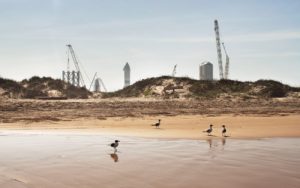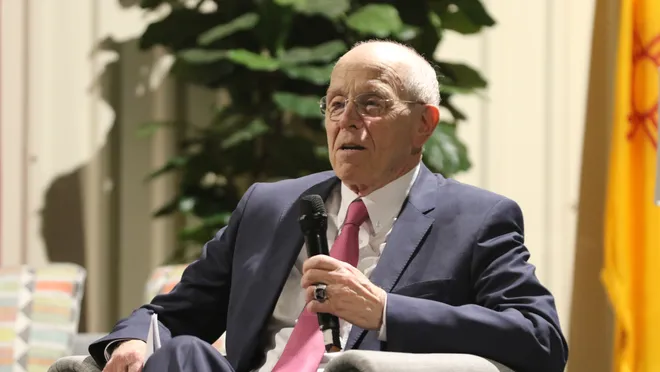 Residents of the South Texas beach town say SpaceX’s billionaire owner is ruining their “little piece of heaven.”
Residents of the South Texas beach town say SpaceX’s billionaire owner is ruining their “little piece of heaven.”
Perhaps in the distant future historians in far-flung corners of the solar system will note that the twenty-first-century Texas space program did not get off to a particularly strong start. The first proper test of the Starship, the (aspirationally) reusable rocket offered by the SpaceX corporation and launched from the southern tip of the Lone Star State, took place on December 9, 2020. The rocket climbed some 41,000 feet, halted as it was supposed to, and returned to its landing pad—much too rapidly. Crunch.
The second test, in February, crunched too. The next, on March 3, appeared to land mostly intact but exploded eight minutes later. On March 30, the fourth test didn’t even make it back to the pad: near the apogee of its flight, it blew up with a calamitous boom, spreading shrapnel more than five miles afield. “Looks like we’ve had another exciting test,” announced the sheepish narrator on SpaceX’s official livestream. “Flying debris and pieces of Starship; there’s stuff smoking on the ground in front of the camera!” said the host of a privately run livestream, one of many catering to the company’s fans, its lens pointed at the landing pad in the town of Boca Chica as steel chunks rained down with frightening velocity. Oh, the humanity!
A little more than two weeks after the last catastrophic failure, NASA officials—those dinosaurs at the federal space program—announced a $2.9 billion contract with SpaceX to use a variant of the Starship as the landing vehicle for NASA’s future missions to the moon. Elon Musk, the company’s brilliant and eccentric founder and CEO—and since December 2020, a resident, at least for tax purposes, of Austin—has long described the Starship tests as an iterative process. SpaceX expects failures, and it hopes to learn from them. On May 5 the Starship finally had a soft landing—though a fire, successfully extinguished, broke out on the landing pad. Still, Musk has a history of overpromising. In September 2019, for example, he predicted that the Starship would be flying earthlings into orbit by the end of 2020. Now, NASA expects him to have the rocket ready to touch down on the lunar surface with astronauts on board within the next few years.
Musk has never been to space, but he seems curiously unbounded by the laws of gravity. In the past decade, he has been at the center of a succession of stories—exploding rockets, spontaneously combusting Teslas, U.S. Securities and Exchange Commission investigations, and a defamation case brought by the hero of the 2018 Thai cave rescue, whom Musk baselessly called a pedophile—from which he only emerges stronger. He has an army of passionate fans and an army of passionate detractors, both of which he enjoys juicing up. He is—on some days, depending on Tesla’s stock price—the world’s richest man, and he warps time and space around him like a bowling ball on a trampoline. There is perhaps no place where his weight is felt more than in Boca Chica, the unincorporated bayside community just north of where the Rio Grande trickles into the Gulf of Mexico. Before Musk arrived in 2014, Boca Chica was home to some of the most unspoiled beaches in Texas, along with a wide variety of threatened and endangered species and a modest community of some forty homes. In just a few years, a small SpaceX launchpad built near the beach, amid a wildlife refuge, has turned into a sprawling compound with hundreds of workers, assembly facilities, and rocket fuel storage tanks. In Boca Chica village, the company ushered out residents, many of them retirees, with what some locals claim were heavy-handed tactics, pressuring them to sell their homes. Local bird populations are under strain as human activity ramps up. During tests, public beaches are frequently closed with little warning or notice.
In exchange, Cameron County is becoming a mecca for Musk fans and space enthusiasts from around the world—and may, indeed, have become an unlikely launchpad to the solar system. Many local elected officials and business leaders in Brownsville see SpaceX as a way to give one of the poorest counties in the state a future. A mural with Musk’s face adorns Brownsville’s downtown, and the city is beginning to see the benefits of his patronage. About an hour after the explosion on March 30, Musk tweeted that he was donating $20 million to area schools and $10 million to the city of Brownsville.
For better or worse, Boca Chica belongs to Elon now. He’s even come up with a new name for the town. “Creating the city of Starbase, Texas,” he tweeted in March, “From thence to Mars, and hence the stars.” Local officials gently reminded the billionaire that he had to ask for permission first.
It’s a gray day in April, and the wind is whipping so hard the surf has surged over State Highway 4, the only road that connects Boca Chica to Brownsville. I’ve come to meet Stephanie Bilodeau, a biologist with the nonprofit Coastal Bend Bays and Estuaries Program. “I used to love coming to work here, before all of this started happening. It was so pristine out in the flats,” she tells me. “There was never anybody out here. Now people come out just to see this,” she says, indicating SpaceX’s latest rocket, which looms over the landscape.
Originally from Vermont and now based in Harlingen, Bilodeau has spent nearly every week since 2017 at Boca Chica, surveying the populations of birds that depend on the mud flats, beaches, and wetlands here to feed, breed, or rest during migration. “Elon always said this was the place to launch rockets because there’s nothing here, that it’s just a big wasteland,” she says. “But that’s just not true. It’s an amazing place for shorebirds. It’s got to be one of the best places for shorebirds in the country.”
Glance at a map, and it’s not immediately clear why this place is special. As the sandpiper flies, it’s not far from the bustling Port of Brownsville and South Padre’s hotels, kitschy shops, and beach bars. But the port’s long ship channel cuts off Boca Chica from the north, while the Rio Grande cuts it off from the south. In between is a wedge of land accessible by the two-lane State Highway 4, which is guarded by a Border Patrol checkpoint. It can feel very remote.
Much of the land here is part of the 10,680-acre Boca Chica tract of the Lower Rio Grande National Wildlife Refuge. Kemp’s ridley turtles, the most endangered sea turtles in the world, nest on the beaches; dolphins swim in the nearby Laguna Madre. The only remaining breeding population of ocelots in the United States lives here. The last confirmed sighting of a jaguarundi in the U.S. happened nearby, in 1986, and there are rumors some may remain.
It is the birds, though, that set Boca Chica apart: egrets, falcons, pelicans, plovers, sandpipers, sparrows, and warblers, among others. There are many species of birds in the Rio Grande Valley that can’t be found anywhere else in the U.S. But it’s a hard time for shorebirds up and down the Gulf Coast. Too much development, too many vehicles, a changing climate. The Boca Chica portion of the wildlife refuge is intended to provide a sanctuary.
When SpaceX first proposed a launch site in Boca Chica, the company suggested that its footprint would be minimal. After buying up tracts of private land amid the wildlife refuge, SpaceX told regulatory agencies that it planned to launch its proven Falcon rockets at the site, along with the Falcon Heavy, the same rocket, with boosters attached. An environmental impact review conducted by the Federal Aviation Administration found that the project was “not likely to jeopardize the continued existence” of sea turtles, ocelots, and other species. But after federal and state authorities gave their approval and construction began, SpaceX changed its plans. Instead of launching the Falcon, the company would use the site as a test facility to develop its much larger and louder Starship and the Starship Super Heavy configuration. The FAA approved the company’s expanded operations, though it is now considering whether a new environmental study is required.
If the Falcon is a cigarette, the Starship is a Churchill cigar. The Falcon Heavy puts out about 5.1 million pounds of thrust; the Starship Super Heavy is projected to have more than 16 million pounds of thrust. Even when the Starship doesn’t blow up, it shakes the ground for miles in every direction. Scientists say the shock waves could potentially cause deafness or brain damage in birds; the rocket engines spit out combusted chemicals. In the aftermath of the March 30 test, there were “a couple hundred people on foot picking up debris,” Bilodeau told me, but there was still a lot of junk around two weeks later when I toured the area with her. Large chunks of twisted steel littered the tidal flats, some of them sticking out of the water. Heavy equipment may be needed to remove some of the bigger pieces.
This time of year, Bilodeau is looking for snowy plovers, wading birds that stand six inches tall and weigh little more than an ounce. Their young are speckled puffballs whose bodies are barely bigger than their legs. They’re not yet endangered, but their numbers have been falling quickly. “In the general vicinity of the launchpad, we’ve seen a decline in the number of nests,” Bilodeau says. Where she used to find dozens, she has this year found just one, far down the beach from the launchpad. It’s not just the rocket launches that are disrupting wildlife, she says, but also the attendant “traffic, the construction, the presence of people, the noise.”
Birding is big business in the Rio Grande Valley, an international destination for avian aficionados. One estimate has it that birding adds about $460 million to the local economy every year. Bilodeau knows many in Brownsville are thrilled to have SpaceX here and may not even be aware of the birds. But it’s hard for her not to be emotionally invested. A few years ago, before SpaceX activity picked up, she watched one snowy plover try, and fail, to build a nest and produce hatchlings six times. “It was hard not to be rooting for her to succeed,” she says. Though the nest failures were due to natural causes, she worries about all the new threats.
SpaceX has plans to expand its facilities and launch rockets more frequently. The company is building an orbital launchpad, which will be the tallest building in the region. Musk envisions Starbase, Texas, as a much larger company town to support his projects—with more workers, more housing, more traffic, more visitors. “I just don’t see how they can build a city here. There’s not enough room,” Bilodeau says.
It’s unclear whether Musk is aware of any of the complaints, but he has offered a solution. The night before I walked the beach with Bilodeau, Musk tweeted: “If we make life multiplanetary, there may come a day when some plants & animals die out on Earth, but are still alive on Mars.” I ask Bilodeau if she can foresee the snowy plover nesting on the red planet. “Probably not,” she says.
Boca Chica village sits in the shadow of the SpaceX compound. Just a few years ago the village was little more than two streets of a few dozen one-story houses and a shrine to the Virgin Mary. Celia Garcia, a retiree in her seventies, bought two houses in Boca Chica in 1992 and 2003. She moved into one in 2019, intending to spend her retirement there, and planned to use the other as a rental home to supplement her social security checks.
“It was our heaven, our little piece of heaven that God gave us,” she said. “And then with SpaceX, everything changed.” Before SpaceX barreled into town, Garcia’s house, which looks out over South Bay a mile and a half from the beach, was part of a place with a strong sense of community and abundant wildlife. Today, she said, “you’ll see more roadkill than you see animals that are alive roaming the area.”
After 2018 the company built infrastructure on all three sides of the village: a solar farm to the south, a company-run RV park with chic Airstream trailers to the west, and storage facilities to the east, behind the shrine to the Virgin. Agents for SpaceX urged the villagers to sell quickly while the county officials publicly warned that eminent domain could be used if they refused. Some residents say the offers were not generous, though they were coming, indirectly, from one of the richest men on the planet. Some accepted the buyouts because living under the shadow of the company had become so onerous. “It was as if I didn’t own my own home,” said Cheryl Stevens, who sold her house in 2019. Garcia says she will only accept a buyout if it’s sufficient for her to buy replacement homes near the water. SpaceX declined to comment for this article. My multiple attempts to reach County Judge Eddie Treviño Jr. and county commissioner Sofia Benavides, who represents Boca Chica on the Cameron County Commissioners Court, were unsuccessful.
Each launch is preceded by a series of tests, which are often announced on short notice and then delayed. For safety reasons, the county orders residents to evacuate their homes and closes State Highway 4, along with the public beach. The tests, and explosions, often break windows in the village. And because the county government was so steadfastly behind SpaceX, Stevens said, “there was absolutely nobody that wanted to hear” about what the villagers were going through, “nobody that cared.”
Today, what’s left of the town exists in a strange kind of superposition between the old and the new, Boca Chica village and Starbase. Some houses—eleven, by Garcia’s count—are still owned by the old residents, gently worn and painted in earth tones. The rest have been repainted black and white and gray. All the new homes sport Tesla chargers in front.
Though Texas is strongly identified with the space program, it only got one piece of the pie when NASA doled out patronage in its early years: the Manned Spacecraft Center in Houston, now the Johnson Space Center. Alabama designed the rockets, Louisiana built them, and Florida launched them. SpaceX, on the other hand, tests its engines in McGregor, near Waco, and assembles and launches rockets in Boca Chica. And someday, perhaps, astronauts launched from South Texas will take orders from Houston again. There’s also Blue Origin, a lagging competitor of SpaceX owned by Amazon magnate Jeff Bezos, which is testing rockets near Van Horn, 120 miles east of El Paso. After a decade of doldrums following the end of the space shuttle program, Texas is back in the business of space.
And so, perhaps, is Cameron County, where more than a third of the children live in poverty. Josh Mejia, the executive director of the Brownsville Community Investment Corporation, says the economic benefits of SpaceX have helped insulate the city from the COVID-19-related recession. UT–Rio Grande Valley has its own building at the SpaceX compound, where researchers work on a project called STARGATE—that’s Spacecraft Tracking and Astronomical Research into Gigahertz Astrophysical Transient Emission, as you might have guessed. Mejia, who grew up in Brownsville but left as an adult to pursue opportunities elsewhere, hopes the boom will help reverse the region’s brain drain. There are the jobs, of course, but also the sense of possibility SpaceX brings. In December, he watched with awe from the roof of city hall as the Starship took off for the first time. “To see that shimmery rocket go up, and to even see it blow up, from as far away as we were, it was a sight to see,” he said.
It is also bringing a new kind of visitor to the area. Among the trickle of gawkers and picture-takers on the day I visit are Frank Gugliuzzi, of Canada, and Noé Bugmann, of Switzerland. The two men recently met by chance at the construction site of Tesla’s new Gigafactory, outside Austin. Bugmann is quiet and pensive, Gugliuzzi giddy with excitement. Having bonded over enthusiasm for Musk and his products, they decided to caravan together to Boca Chica (Gugliuzzi drove his Ontario-plated Tesla Model 3). Their week in South Texas has been thrilling; last night, Musk responded to one of Gugliuzzi’s tweets, a video of the Gigafactory, shot from a drone. Guliuz-
zi is considering moving to Texas.
The pair stare up at the rocket on its pad. It is a handsome ship, made from shiny stainless steel. Its broad fins make it look like a spaceship that a comic book artist in the fifties might have drawn, phallic in an uncomplicated way. The facility is thick with tanks and silos of liquid oxygen and methane. Gizmos spin and whir. Gugliuzzi says they may stay in Brownsville until this Starship launches, which could be more than a week away. “I wish I could stand right here when it launches,” he says. “It would probably be pretty hot.” Nearby, another group of onlookers clambers out of their car. What does this place mean to Gugliuzzi and Bugmann, I ask? What could draw these two so far from home? Gugliuzzi laughs and shrugs, as if the answer is obvious. “It’s the future.”
Source: https://www.texasmonthly.com/news-politics/elon-musk-boca-chica-starbase-texas/




0 Comments